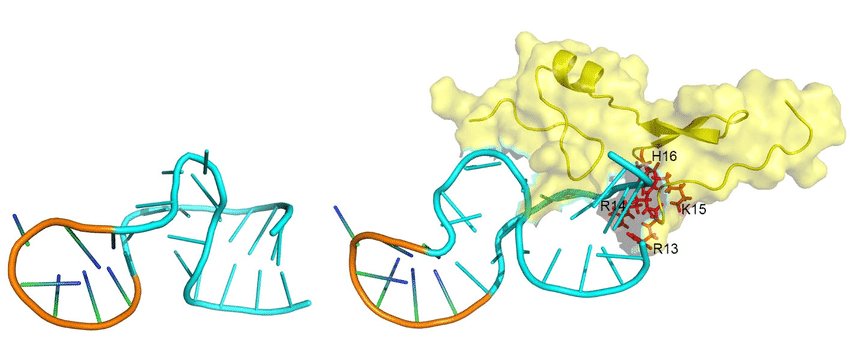Analyzing the structure of your interest aptamers and their binding complex is beneficial for the exploration of potential therapeutic aptamers and targets. Creative Biolabs is a leading biotechnology company that has the expertise and ability in providing aptamers structure analysis service for customers worldwide.
Basic Knowledge of Aptamer
For a long time, the nucleic acid has always been considered as a compound functioning to store and transmit genetic information. Until the 1980s, it was reported that several small RNAs isolated from the human immunodeficiency virus (HIV) and adenovirus could bind to viral or cellular proteins with high affinity and specificity. And later in 1990, the advent of the Systematic Evolution of Ligands by EXponential enrichment (SELEX) has greatly promoted the development of nucleic acid aptamers.
Currently, aptamers generally refer to these small oligonucleotides or peptides (in a few cases) that can bind to the targets with high affinity and specificity. The chemical nature of nucleic acid aptamers is single-strand ribonucleic acid or deoxyribonucleic acid sequences, which are synthesized artificially in vitro and are generally 20-60 nucleotides in length with 6-30 kDa molecular weights. Aptamers are also known as “chemical antibodies” since they fold into unique three-dimensional conformations and recognize and bind to the targets in an antibody-like manner.
 Fig. 1 Schematic diagram of aptamer conformational recognition of targets to form an aptamer-target complex.1
Fig. 1 Schematic diagram of aptamer conformational recognition of targets to form an aptamer-target complex.1
Aptamer Structure Analysis Services at Creative Biolabs
The binding of aptamers to ligands or targets is based on the diversity of single-strand nucleic acid structure and spatial conformation. In the presence of target molecules, aptamers form stable three-dimensional (3D) structures such as hairpins, pseudoknot, stem-loop, G2quartet through self-adaptive folding, such as complementary base pairs, van der Waals forces, electrostatic interaction, hydrogen bonding, etc. In this way, a relatively larger contact area can be formed between the aptamer and the target molecule, and the aptamer can closely bind to the target substance with high affinity and specificity. Therefore, it is meaningful to perform a structural analysis of the aptamer and the binding complex.
Creative Biolabs, a leading biotechnology company dedicated to novel therapy discovery, has been recognized as an excellent supplier of aptamer development service providing. Based on advanced technologies and abundant experience, our seasoned scientists provide professional and comprehensive aptamer structure analysis services on three levels:
-
3D structure determination
-
3D structure modeling
Our Highlighted Advantages
-
Different technologies and approaches for aptamer structure analysis
-
One-stop and high-quality solutions
-
An excellent expert team supports the whole process
-
Perfect after-sale service system and free consultation
Contact us directly for more information about aptamer development. Our seasoned scientists will reply to you with a custom solution as soon as possible.
Reference
-
By Ning Zhang, Zihao Chen, Dingdong Liu, Hewen Jiang, Zong-Kang Zhang, Aiping Lu, Bao-Ting Zhang, Yuanyuan Yu, and Ge Zhang - Zhang, N., Chen, Z., Liu, D., Jiang, H., Zhang, Z. K., Lu, A., ... & Zhang, G. (2021). Structural biology for the molecular insight between aptamers and target proteins. International Journal of Molecular Sciences, 22(8), 4093. Publisher: MDPI., CC BY 4.0, https://commons.wikimedia.org/w/index.php?curid=119979335
Related Product
Questions & Answer
A: Common techniques for aptamer structure analysis include nuclear magnetic resonance (NMR) spectroscopy, X-ray crystallography, cryo-electron microscopy (cryo-EM), and computational modeling.
A: Computational modeling techniques, such as molecular docking and molecular dynamics simulations, are used to predict and refine the structures of aptamer-target complexes based on experimental data or to generate models in the absence of experimental structures.
A: By understanding the structure-function relationships of aptamers, aptamer structure analysis can guide the rational design and optimization of aptamers with improved binding affinity, specificity, and stability. Aptamer structure analysis contributes to the development of aptamer-based therapeutics for diseases, such as cancer and viral infections, as well as the design of aptamer-based biosensors for diagnostic purposes and targeted drug delivery systems.
For Research Use Only.
Related Sections:

 Fig. 1 Schematic diagram of aptamer conformational recognition of targets to form an aptamer-target complex.1
Fig. 1 Schematic diagram of aptamer conformational recognition of targets to form an aptamer-target complex.1